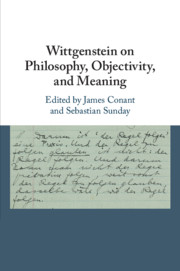Book contents
- Wittgenstein on Philosophy, Objectivity, and Meaning
- Wittgenstein on Philosophy, Objectivity, and Meaning
- Copyright page
- Contents
- Contributors
- Preface
- Acknowledgments
- Chapter 1 Anatomy of a Muddle: Wittgenstein and Philosophy
- Chapter 2 Explaining What We Mean
- Chapter 3 Objectivity
- Chapter 4 The Methodological Significance of Intuitions in Philosophy
- Chapter 5 Wittgenstein on ‘Seeing Meanings’
- Chapter 6 Bringing the Phenomenal World into View
- Chapter 7 First Steps and Conceptual Creativity
- Chapter 8 Wittgenstein and Analytic Revisionism
- Chapter 9 Demystifying Meaning in Horwich and Wittgenstein
- Chapter 10 What Is Meaning? A Wittgensteinian Answer to an Un-Wittgensteinian Question
- Chapter 11 Meaning, Use, and Supervenience
- Chapter 12 Some Socratic Aspects of Wittgenstein’s Conception of Philosophy
- References
- Index
Chapter 6 - Bringing the Phenomenal World into View
Published online by Cambridge University Press: 15 August 2019
- Wittgenstein on Philosophy, Objectivity, and Meaning
- Wittgenstein on Philosophy, Objectivity, and Meaning
- Copyright page
- Contents
- Contributors
- Preface
- Acknowledgments
- Chapter 1 Anatomy of a Muddle: Wittgenstein and Philosophy
- Chapter 2 Explaining What We Mean
- Chapter 3 Objectivity
- Chapter 4 The Methodological Significance of Intuitions in Philosophy
- Chapter 5 Wittgenstein on ‘Seeing Meanings’
- Chapter 6 Bringing the Phenomenal World into View
- Chapter 7 First Steps and Conceptual Creativity
- Chapter 8 Wittgenstein and Analytic Revisionism
- Chapter 9 Demystifying Meaning in Horwich and Wittgenstein
- Chapter 10 What Is Meaning? A Wittgensteinian Answer to an Un-Wittgensteinian Question
- Chapter 11 Meaning, Use, and Supervenience
- Chapter 12 Some Socratic Aspects of Wittgenstein’s Conception of Philosophy
- References
- Index
Summary
The argument of this chapter proceeds in the form of constructive criticism of Charles Travis’s recent work on perception. Travis has presented a powerful argument against the idea that perception, as such, provides us with true-or-false representations of the world. The representationalist view, Travis argues, fails to respect the fundamental Fregean distinction between "the conceptual" and "the nonconceptual." According to Travis, what perception presents us with is nonconceptual; hence, perception is indeterminate as far as representational content goes. Travis argues that determinate representational content, on the other hand, is only created when things are judged to be some particular way or another. In this chapter, Avner Baz finds himself in substantial agreement with Travis, but argues that something important also goes missing in the latter’s account, namely what Baz calls "the phenomenal world"; that is, the world as perceived and responded toprior to becoming the object of true or false judgments. In particular, Baz shows how Travis consistently represses the phenomenal world in his account of perception whenever he attempts to explain the perception of what Wittgenstein calls "aspects"; for any respectable account of the perception of such aspects, Baz argues, ought to bring the phenomenal world into view.
Keywords
- Type
- Chapter
- Information
- Wittgenstein on Philosophy, Objectivity, and Meaning , pp. 100 - 118Publisher: Cambridge University PressPrint publication year: 2019
- 1
- Cited by



